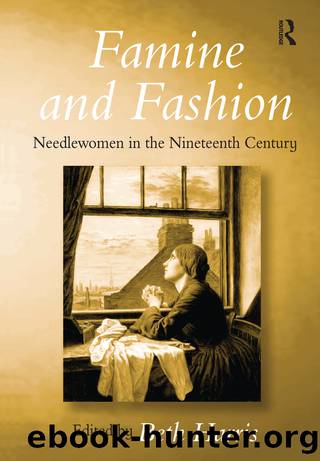Famine and Fashion by Harris Beth;

Author:Harris, Beth;
Language: eng
Format: epub
Publisher: Taylor & Francis Group
Conceptual Questions
Although the apparent specificity of statistics and the construction of "typical" needleworkers is appealing, neat percentages obscure the constant quandaries facing an historian who attempts to identify and count the businesswomen in a nineteenth-century city or neighborhood. Indeed, in the process of compiling and linking information on needleworker-businesswomen, one encounters a series of theoretical questions that confound the notion of a precise quantitative analysis of a distinct population.
That is, as one sifts through the voluminous evidence on female proprietors engaged in the type of minuscule commercial enterprises that might be better labeled "self-employment" than "entrepreneurship," questions arise around issues of proprietorship and length of business activity. For manyâif not mostâof Albany's female microentrepreneurs, proprietorship could be hidden by the presence of male relatives, evidence on trades can be ambiguous or even contradictory, and the length of business activity can prove extremely difficult to determine with accuracy.26
Specific conceptual questions arise in the study of craftswomen who were also proprietorsâmost specifically, who in this category should be included as "businesswomen?" Within the mass of self-employed, home-based working women, is it really possible to make a clear distinction between small businesses (generally assessed in positive terms by both contemporary observers and later historians) and homework or the sweated trades, with their notorious connotations of victimization? That is, how can one distinguish a dressmaker-entrepreneur running a small shop from what one might think of as a "freelance" dressmaker going out by the day to her patrons' homes, from the independent dressmaker who brought her work back home and sewed far into the night? Is it really possible to distinguish between a milliner operating a store and one who did only what was described as "custom work" at homeâand to what extent do such distinctions matter?
Cases from the R.G. Dun & Co. credit ledgers illuminate this difficulty. According to these reports, it was only the exceptional female dressmaking entrepreneur whoâlike Campbell's Madame Mâ or Albany's Madame J. DeBlockâdid a "large business]," enjoyed "the very cream of the trade," and received "high prices for her work."27 Far more usual were those dressmakers and milliners who were said to be "doing quite a light business," with "very small means," making "nothing over a living," and should pay their suppliers "COD." Thus, Anna Andrews's first credit entries in the late 1850s note that she "has a small st[oc]k in a front room of a dwelling" and call her a "private milliner" who "buys goods only to make up"âthat is, she worked on consignment rather than offering a large selection of goods for retail sale.28
In the following decade, milliner and dressmaker Isabella Bussey was said to have a "nice little store" in 1867, but by 1869 she had "no store." Instead, the examiners reported in staccato phrases, she "does work by the job. Has a machine. Makes about a living, no credit." Four years later, examiners considered her of "no ac[count] whatever," and complained that she was "constantly changing style [that is, the ownership of the concern] between herself & husband.
Download
This site does not store any files on its server. We only index and link to content provided by other sites. Please contact the content providers to delete copyright contents if any and email us, we'll remove relevant links or contents immediately.
The Power of Myth by Joseph Campbell & Bill Moyers(940)
Half Moon Bay by Jonathan Kellerman & Jesse Kellerman(921)
A Social History of the Media by Peter Burke & Peter Burke(888)
Inseparable by Emma Donoghue(855)
The Nets of Modernism: Henry James, Virginia Woolf, James Joyce, and Sigmund Freud by Maud Ellmann(773)
The Spike by Mark Humphries;(730)
A Theory of Narrative Drawing by Simon Grennan(717)
The Complete Correspondence 1928-1940 by Theodor W. Adorno & Walter Benjamin(712)
Ideology by Eagleton Terry;(666)
Bodies from the Library 3 by Tony Medawar(657)
World Philology by(650)
Culture by Terry Eagleton(649)
Farnsworth's Classical English Rhetoric by Ward Farnsworth(648)
Adam Smith by Jonathan Conlin(620)
A Reader’s Companion to J. D. Salinger’s The Catcher in the Rye by Peter Beidler(616)
Game of Thrones and Philosophy by William Irwin(604)
High Albania by M. Edith Durham(599)
Comic Genius: Portraits of Funny People by(588)
Monkey King by Wu Cheng'en(583)
